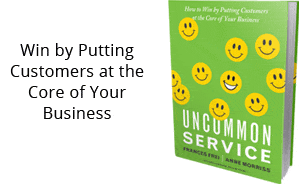A Refreshing and Pragmatic Approach On How To Deliver Excellent Customer Service
“Uncommon Service – How to Win by Putting Customers at the Core of Your Business”

By Frances Frei & Anne Morriss
Published 2012
By Harvard Business Review Press
– Create an environment within your organisation where all employees focus on delivering excellent customer service.
In this recently released book, Frei and Morriss identify four key dimensions to achieve excellent customer service. Organisations need to both recognise and manage each of these areas effectively.
Customer Service Dimensions
Four dimensions of business for delivering customer service:
– defining your service offering and how customers will perceive customer service excellence
– defining the mechanism for funding customer service excellence
– defining the employee management system to allow employees to deliver customer service excellence
– defining the customer management system to facilitate the improvement of customer experience
Service models need to be designed around all of these dimensions.
Each dimension is broken down, analysed and backed with relevant, contemporary case studies.
Case studies are drawn from organisations spanning finance, retail, travel, healthcare and freight services.
The authors contend that customer service excellence comes at a price, and that price is the tradeoff between being good at everything or being excellent at your core competency.
Trying to be the best at everything is counterproductive to customer service excellence. Deliberate tradeoffs can lead to delivering excellent customer service in those areas that your customers value most.
The key to this approach is in identifying those service attributes on which you are competing for customers, then determining how to fund service delivery in those areas, define management systems and business processes to facilitate employees in delivering excellence in those areas, and finally, managing the customer experience.
Customer Service – Link to Leadership and Organisational Culture
The strength of this book lies in linking the identified four dimensions with the requirement for a strong organisational culture; a culture that has clarity of purpose, is consistent with the organisational strategy, structure and operations, and is effectively communicated and universally understood within the organisation. This requires leadership to create a culture and environment that reinforces the service model at every touchpoint.
Frei and Morriss conclude by highlighting that “employees are yearning to be of service, customers are eager to do their part, and organisations can, in fact, change overnight”. As with most challenges in life, change commences with a clarity of vision of what is possible, and the unwavering belief in realising that vision.
It is this pragmatic approach in “Uncommon Service” that is refreshing.
I highly recommend this book to anyone who is delivering a customer service.
Australian and New Zealand customers can purchase this book through the link on our Recommended Reading page (under Resources).
Please share your comments below!
Read more here: http://uncommonservice.com/
Return to: Customer Experience Services


